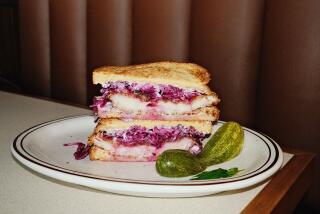Neighborhood’s flavor is changing
NEW YORK — If pickles were currency, it would take 100 of Pat Fairhurst’s kosher sours to buy a buttery smooth leather wallet in the chic shop nearby, more than 200 to snag a dress off one of the neighboring boutiques’ racks, and a whopping 1,000 to book a luxury suite at the Blue Moon Hotel across the street.
That helps explain why Fairhurst’s tiny store, Guss’, an institution since 1920 in Manhattan’s Lower East Side, is moving its red barrels of 50-cent pickles to Brooklyn.
No longer the exclusive domain of scrappy immigrants or Jewish aficionados of Fairhurst’s briny treats, the old neighborhood has morphed into one of New York’s trendier districts, an evolution that is vexing to those nostalgic for the past but who admit that change can be good.
On a hot summer Sunday, Stacy Soberalski remembered a real estate agent once warning her away from the area, citing drug dealing and other crime.
“Now, six years later, it’s Mister Rogers’ neighborhood!” Soberalski said as her companion, Adam Hersly, chose from Fairhurst’s fermented goods.
Soberalski admitted to being torn about the change. “I liked the old school. It’s what made the neighborhood what it was,” she said.
“But it’s nice to have all these high-end shops here. Out with the old and in with the new, I guess.”
Even Fairhurst, who spends hours tending her barrels at the shop on Orchard Street, a baseball cap shielding her face from the sun, admitted that gentrification is inevitable, especially in a neighborhood that once was the first home for the poorest of America’s new immigrants.
As their fortunes changed, the populations changed. People moved up and out of the squalid tenements that are now renovated apartments fetching more than $2,000 -- or 4,000 of Guss’ pickles -- a month.
Change has been in the works for decades, but Fairhurst traces her store’s sharpest downturn to the Sept. 11, 2001, attacks. Much of Lower Manhattan was a dusty wasteland for weeks afterward. When the mess was cleared up, people were afraid to come back.
The newcomers who moved in were different than the old-timers, who had worked 9-to-5, stocked up on pickles and other Jewish favorites in advance of the Sabbath, and didn’t have Whole Foods or Trader Joe’s.
“It’s just timing and generations. Now everyone has to work until late, and it’s easier for them to get pickles in the supermarket,” Fairhurst said.
Her departure, planned for fall after the Jewish holidays of Rosh Hashana and Yom Kippur, will leave Alan Kaufman and his Pickle Guys shop two streets away the sole pickle proprietor in the neighborhood.
Kaufman, whose large store boasts rows of barrels brimming with such fare as traditional kosher sours or jalapeno-stuffed olives, isn’t celebrating.
To Kaufman, who banters with his steady stream of customers while dishing goods into containers, it’s just a sign of the changes that have left the rival pickle peddlers with different sets of customers.
Kaufman has expanded his product line to about 50 items, and he ships nationwide. Clientele can find pepperoncini to dress their salads and creamed herring to line their arteries.
Asked the biggest misconception people have about pickles, Kaufman didn’t hesitate. “That all pickles are alike,” he bellowed above the din of the Sunday crowd.
His pickles are 25 cents more than Fairhurst’s, but Kaufman said there’s a reason. “Once you’ve bought these pickles, you can’t buy store-bought pickles.”
Paul Shapiro, who lives a three-hour drive away in Albany and is a loyalist of the Pickle Guys, agreed. He grew up in New York City and always came to the Lower East Side for pickles.
“There’s not many traditional places left in the Lower East Side,” said Shapiro, who said he wouldn’t dream of leaving the city without stocking up at Kaufman’s store.
“For me, it’s not so bad,” he said of the change. “But it’s life in New York. New York evolves.”
That’s a good thing, said Morris Vogel, president of the Lower East Side Tenement Museum, explaining that successful cities are forever changing.
“This neighborhood was an area of first settlements. That’s not a role you can continue to play,” said Vogel, a history professor at Temple University, as he led a walking tour, pointing out remnants of bygone eras: the ornate facade of a long-shuttered theater; the faded pink building that housed one of the city’s earliest department stores; bricked-up synagogues.
“It’s unrealistic of us to freeze this in a moment,” he said, noting that many of the chic new businesses in the area are also run by immigrants -- just not the same immigrants who once ran the hosiery and pickle stores.
--
More to Read
Eat your way across L.A.
Get our weekly Tasting Notes newsletter for reviews, news and more.
You may occasionally receive promotional content from the Los Angeles Times.









